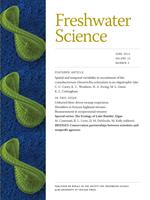Recruitment from dormant stages in the benthos can provide a critically important inoculum for surface populations of phytoplankton, including bloom-forming cyanobacteria. For example, water-column populations of the large (1–3-mm diameter) colonial cyanobacterium Gloeotrichia echinulata (Smith) P. Richter can be strongly subsidized by benthic recruitment. Therefore, understanding controls on recruitment is essential to an investigation of the factors controlling Gloeotrichia blooms, which are increasing in low-nutrient lakes across northeastern North America. We quantified surface abundances and recruitment from littoral sediments at multiple near-shore sampling sites in oligotrophic Lake Sunapee, New Hampshire, USA, during the summers of 2005–2012 and used this data set—the longest known record of cyanobacterial recruitment—to investigate potential drivers of interannual differences in Gloeotrichia recruitment. We found extensive spatiotemporal variability in recruitment. Recruitment was higher at some sites than others, and within seasons, recruitment into replicate traps at the same site was generally more similar than recruitment at different sites. These data suggest that local factors, such as substrate quality or the size of the seed bank, may be important controls on recruitment. Benthic recruitment probably accounted for <4%, but possibly up to 8%, of pelagic populations, within the range observed in previous studies. Across years, higher seasonal recruitment rates were associated with greater lake mixing during August, including deeper thermoclines, lower Schmidt stability, lower minimum air temperatures, and greater variability in water temperature. Taken together, our data suggest that interannual variation in Gloeotrichia recruitment may be related to regional climatic variability.
How to translate text using browser tools
25 March 2014
Spatial and temporal variability in recruitment of the cyanobacterium Gloeotrichia echinulata in an oligotrophic lake
Cayelan C. Carey,
Kathleen C. Weathers,
Holly A. Ewing,
Meredith L. Greer,
Kathryn L. Cottingham
ACCESS THE FULL ARTICLE
It is not available for individual sale.
This article is only available to subscribers.
It is not available for individual sale.
It is not available for individual sale.

Freshwater Science
Vol. 33 • No. 2
June 2014
Vol. 33 • No. 2
June 2014
akinetes
benthic—pelagic coupling
climate change
dormancy
lake stratification
phytoplankton




